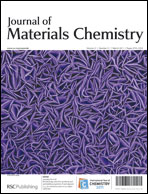Microwave-hydrothermally synthesized (Sr1−x−yCexTby)Si2O2−δN2+μ phosphors: efficient energy transfer, structural refinement and photoluminescence properties
Abstract
A facile microwave-assisted
With increasing the Tb3+ concentration, the Tb3+ emission intensity enhanced and reached a maximum with the Tb3+ concentration of 2 mol%, then decreased due to the concentration quenching effect. It is also observed that the intensity of the Ce3+ emission peak decreased gradually. This indicates the effective energy transfer from Ce3+ to Tb3+ ions. The CIE coordinate of (Sr1−x−yCexTby)Si2O2−δN2+μ phosphors shifted from the blue region towards the green region with increasing Tb3+ concentration. The above findings indicate that the emitting colors of the microwave-hydrothermally derived (Sr1−x−yCexTby)Si2O2−δN2+μ phosphors can be tuned over a wide range under UV excitation.


 Please wait while we load your content...
Please wait while we load your content...